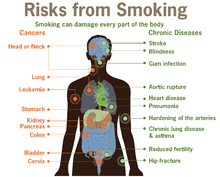The most common method of smoking today is through cigarettes, primarily industrially manufactured but also hand-rolled from loose tobacco and rolling paper. Other smoking implements include pipes, cigars, bidis, hookahs, vaporizers, and bongs. It has been suggested that smoking-related disease kills one half of all long term smokers but these diseases may also be contracted by non-smokers. A 2007 report states that about 4.9 million people worldwide each year die as a result of smoking.
Smoking is one of the most common forms of recreational drug use. Tobacco smoking is today by far the most popular form of smoking and is practiced by over one billion people in the majority of all human societies. Less common drugs for smoking include cannabis and opium. Some of the substances are classified as hard narcotics, like heroin, but the use of these is very limited as they are often not commercially available.
The history of smoking can be dated to as early as 5000 BC, and has been recorded in many different cultures across the world. Early smoking evolved in association with religious ceremonies; as offerings to deities, in cleansing rituals or to allow shamans and priests to alter their minds for purposes of divination or spiritual enlightenment. After the European exploration and conquest of the Americans, the practice of smoking tobacco quickly spread to the rest of the world. In regions like India and Subsaharan Africa, it merged with existing practices of smoking (mostly of cannabis). In Europe, it introduced a new type of social activity and a form of drug intake which previously had been unknown.
Perception surrounding smoking has varied over time and from one place to another; holy and sinful, sophisticated and vulgar, a panacea and deadly health hazard. Only relatively recently, and primarily in industrialized Western countries, has smoking come to be viewed in a decidedly negative light. Today medical studies have proven that smoking tobacco is among the leading causes of many diseases such as lung cancer, heart attacks, COPD, erectile dysfunction and can also lead to birth defects. The inherent health hazards of smoking have caused many countries to institute high taxes on tobacco products and anti-smoking campaigns are launched every year in an attempt to curb tobacco smoking.
Health effects
Main article: Health
effects of tobacco
Smoking is one of the leading causes of preventable death globally.
In the United States about 500,000 deaths per year are attributed to
smoking-related diseases and a recent study estimated that as much as 1/3 of
China's male population will have significantly shortened life-spans due to
smoking. Male and female
smokers lose an average of 13.2 and 14.5 years of life, respectively. At least half of
all lifelong smokers die earlier as a result of smoking.The risk of dying
from lung cancer before age 85 is 22.1% for a male smoker and 11.9% for a female
current smoker, in the absence of competing causes of death. The corresponding
estimates for lifelong nonsmokers are a 1.1% probability of dying from lung
cancer before age 85 for a man of European descent, and a 0.8% probability for a
woman. Smoking one
cigarette a day results in a risk of heart disease that is halfway between that
of a smoker and a non-smoker. The non-linear dose response relationship is explained
by smoking's effect on platelet aggregation.Among the diseases that can be caused by smoking are vascular stenosis, lung cancer,heart attacks and chronic obstructive pulmonary disease Smoking during pregnancy may cause ADHD to a fetus.
Many governments are trying to deter people from smoking with anti-smoking campaigns in mass media stressing the harmful long-term effects of smoking. Passive smoking, or secondhand smoking, which affects people in the immediate vicinity of smokers, is a major reason for the enforcement of smoking bans. This is a law enforced to stop individuals smoking in indoor public places, such as bars, pubs and restaurants. The idea behind this is to discourage smoking by making it more inconvenient, and to stop harmful smoke being present in enclosed public spaces. A common concern among legislators is to discourage smoking among minors and many states have passed laws against selling tobacco products to underage customers. Many developing countries have not adopted anti-smoking policies, leading some to call for anti-smoking campaigns and further education to explain the negative effects of ETS (Environmental Tobacco Smoke) in developing countries.
Despite the many bans, European countries still hold 18 of the top 20 spots, and according to the ERC, a market research company, the heaviest smokers are from Greece, averaging 3,000 cigarettes per person in 2007. Rates of smoking have leveled off or declined in the developed world but continue to rise in developing countries. Smoking rates in the United States have dropped by half from 1965 to 2006, falling from 42% to 20.8% in adults.
The effects of addiction on society vary considerably between different substances that can be smoked and the indirect social problems that they cause, in great part because of the differences in legislation and the enforcement of narcotics legislation around the world. Though nicotine is a highly addictive drug, its effects on cognition are not as intense or noticeable as other drugs such as, cocaine, amphetamines or any of the opiates (including heroin and morphine).
Smoking is a risk factor in Alzheimer's Disease. While smoking more than 15 cigarettes per day has been shown to worsen the symptoms of Crohn's Disease, smoking has been shown to actually lower the prevalence of ulcerative colitis.




.jpg)


.jpg)











No comments:
Post a Comment